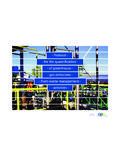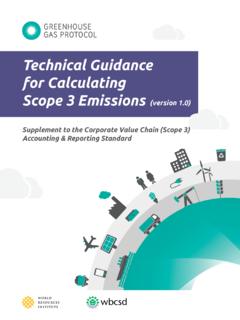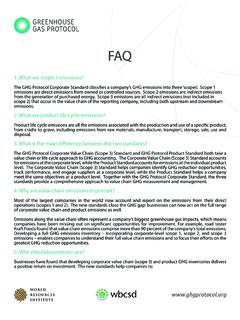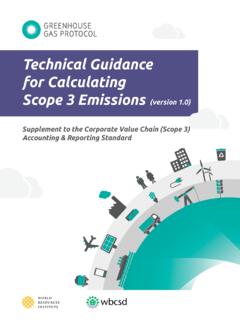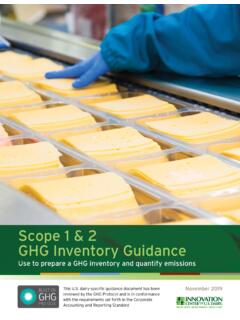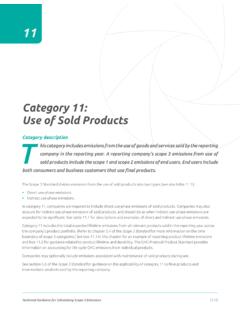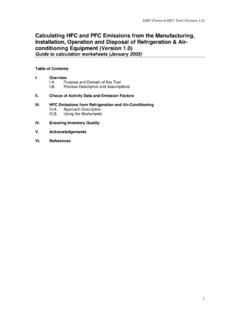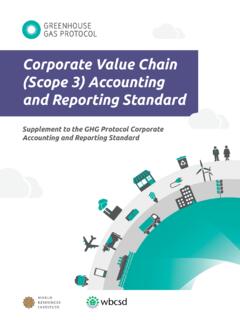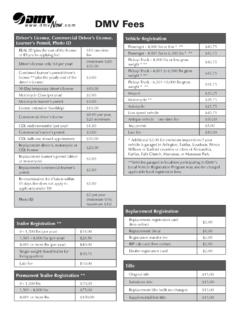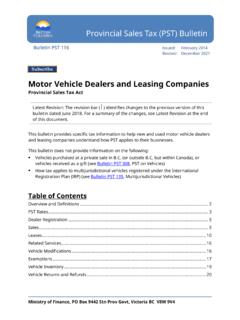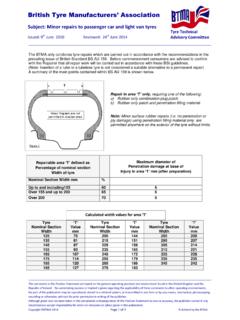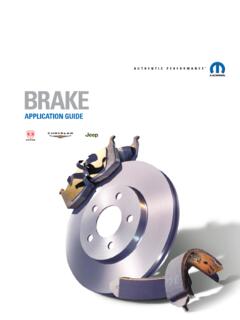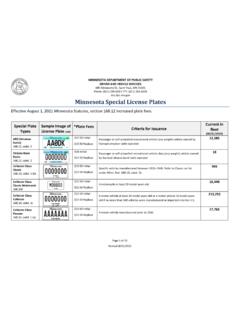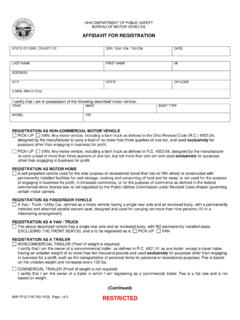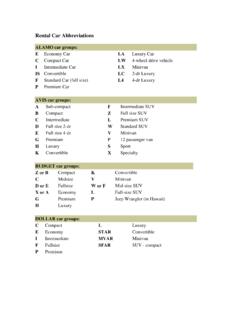Transcription of Category 7: Employee Commuting
1 Technical Guidance for Calculating Scope 3 Emissions [87] 7 Category 7: Employee CommutingCategory descriptionThis Category includes emissions from the transportation of employees4 between their homes and their worksites. Emissions from Employee Commuting may arise from: Automobile travel Bus travel Rail travel Air travel Other modes of transportation ( , subway, bicycling, walking).Companies may include emissions from teleworking ( , employees working remotely) in this Category . A reporting company s scope 3 emissions from Employee Commuting include the scope 1 and scope 2 emissions of employees and third-party transportation emissions from Employee commutingFigure offers a decision tree for selecting a calculation method for scope 3 emissions from Employee Commuting .
2 Companies may use one of the following methods: Fuel-based method, which involves determining the amount of fuel consumed during Commuting and applying the appropriate emission factor for that fuel Distance-based method, which involves collecting data from employees on Commuting patterns ( , distance travelled and mode used for Commuting ) and applying appropriate emission factors for the modes used Average-data method, which involves estimating emissions from Employee Commuting based on average ( , national) data on Commuting Employees refers to employees of entities and facilities owned, operated, or leased by the reporting company. Companies may include employees of other relevant entities ( , franchises or outsourced operations) in this Category , as well as consultants, contractors, and other individuals who are not employees of the company, but commute to facilities owned and operated by the Guidance for Calculating Scope 3 Emissions [88] Category 7 Employee CommutingFigure [ ] Decision tree for selecting a calculation method for emissions from Employee Commuting Fuel-based methodIf data is available on the quantity or amount spent on fuel by employees for Commuting , companies may apply the fuel-based method.
3 The calculation methodology for the fuel-based method is the same as the fuel-based method in Category 4 (Upstream transport and distribution). For guidance on calculating emissions using this method, refer to the guidance for Category 4 (Upstream transport and distribution). If the fuel-based method is used to calculate emissions from Commuting on public transport, then emissions need to be allocated to the Employee (s). For more information on allocation, see chapter 8 of the Scope 3 methodActivity data neededCompanies should collect data on the following: Total distance travelled by employees over the reporting period ( , passenger -kilometers travelled) Mode of transport used for Commuting ( , train, subway, bus, car, bicycle).
4 Use the average-data methodnoUse the distance-based methodIs data available on distance travelled and the mode of transport used by employees?Use the fuel-based methodnonoIs data available on the types and quantities or cost of fuels consumed during transportation?yesyesyesDoes Employee Commuting contribute significantly to scope 3 emissions (based on screening) or are emissions from Employee Commuting otherwise relevant to the business goals? Technical Guidance for Calculating Scope 3 Emissions [89] Category 7 Employee CommutingEmission factors neededCompanies should collect: Emission factors for each mode of transport (usually expressed in units of greenhouse gas (CO2, CH4, N2O, or CO2e) emitted per passenger -kilometers travelled).
5 Note: For air travel emission factors, multipliers or other corrections to account for radiative forcing may be applied to the GWP of emissions arising from aircraft transport. Where used, companies should disclose the specific factor collection guidanceCompanies should collect data on Employee Commuting habits, for example through a survey. Companies should survey their employees annually to obtain information on average Commuting habits. Types of data to collect include: Distance travelled by employees per day, or location of residence and office The number of days per week that employees use different vehicle types (all categories of subway, car, bus, train, bicycle, etc.)
6 Number of Commuting days per week and number of weeks worked per year If the company is multinational: employees region of residence/work (since transportation emission factors vary by region) Whether there is a significant car-pooling scheme in operation, the proportion of employees using the scheme and the average occupancy per vehicle If applicable, the amount of energy used from teleworking ( , kWh of gas, electricity consumed).Collecting Commuting data from all employees through a survey may not be feasible. Companies may extrapolate from a representative sample of employees to represent the total Commuting patterns of all employees. For example, a company with 4,000 employees, who each have different Commuting profiles, may extrapolate from a representative sample of, for example, 1,000 employees to approximate the total Commuting of all employees.
7 See Appendix A for more information on formula [ ] Distance-based methodCO2e emissions from Employee travel =first, sum across all employees to determine total distance travelled using each vehicle type:total distance travelled by vehicle type (vehicle-km or passenger -km)= (daily one-way distance between home and work (km) 2 number of Commuting days per year)then, sum across vehicle types to determine total emissions:kg CO2e from Employee Commuting = (total distance travelled by vehicle type (vehicle-km or passenger -km) vehicle specific emission factor (kg CO2e/vehicle-km or kg CO2e/ passenger -km))+(optionally) for each energy source used in teleworking: (quantities of energy consumed (kWh) emission factor for energy source (kg CO2e/kWh))Technical Guidance for Calculating Scope 3 Emissions [90] Category 7 Employee Commuting Companies should convert daily Commuting distance into annual Commuting distance by multiplying the daily distance by the number of times the trip occurs during the reporting period.
8 For example, if a company collects distance data on one-way journeys, the company should multiply the distance by the number of working days in the reporting year, and then multiply by two to account for daily return data by transport mode should be summed across all employees to obtain total annual kilometers or passenger -kilometers travelled by each mode of may optionally calculate the emissions of teleworking from home. To calculate these emissions, a baseline emissions scenario should first be established. Baseline emissions occur regardless of whether or not the Employee was at home ( , energy consumed by the refrigerator). The reporting company should only account for the additional emissions resulting from working from home, for example the electricity usage as a result of running the air conditioner to stay [ ] Calculating emissions from Employee travel using the distance-based methodCompany A is a small advertising services company, with three employees working 48 weeks per year.
9 To calculate emissions from Employee Commuting , it creates an Employee Commuting profile for each Employee . Each Employee completes a questionnaire the results of which are summarized in the following table:EmployeeRail commute (times per week)One way distance by rail (km)Rail emission factor (kg CO2e/ passenger - kilometer)Car commute (times per weekCar emission factor (kg CO2e/vehicle- kilometer)One way distance by car (km) : The activity data and emissions factors are illustrative only, and do not refer to actual data. the total distance travelled by rail (km) is calculated as: (daily one way distance between home and work (km) 2 5 number of Commuting weeks per year)= (10 2 5 48) + (10 2 4 48) = 8,640 kmthe total distance travelled by car (km) is calculated as: (daily one way distance between home and work (km) 2 5 number of Commuting weeks per year)= (15 2 1 48) + (20 2 5 48) = 11,040 kmtotal emissions from Employee Commuting for the reporting year is calculated as.)
10 (total distance travelled by vehicle type (vehicle-km or passenger -km) vehicle specific emission factor (kg CO2e/vehicle-km or kg CO2e/ passenger -km))= (8,640 ) + (11,040 ) = 3,072 kg CO2eTechnical Guidance for Calculating Scope 3 Emissions [91] Category 7 Employee CommutingAverage-data methodIf company specific data is unavailable, companies may use average secondary activity data to estimate distance travelled and mode of transport. This may include using: Average daily Commuting distances of typical employees Average modes of transport of typical employees Average number of Commuting days per week and average number of weeks worked per estimation requires making several simplifying assumptions, which add uncertainty to the emissions estimates.
